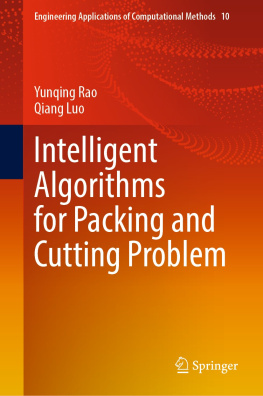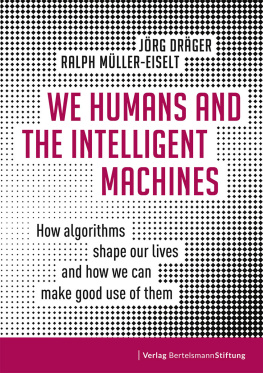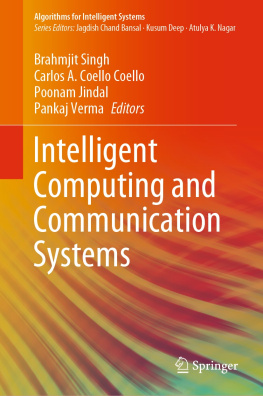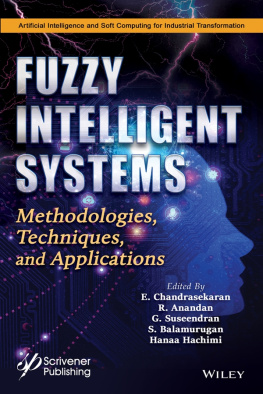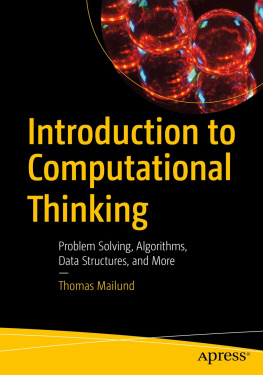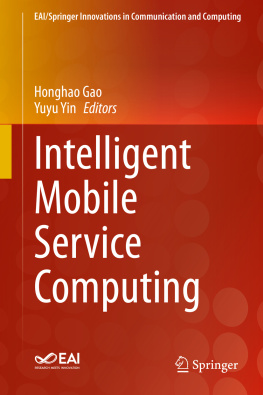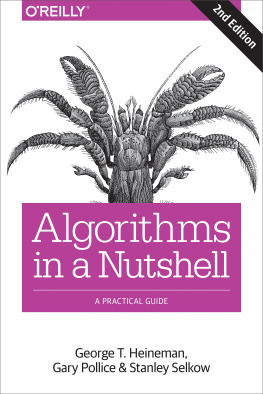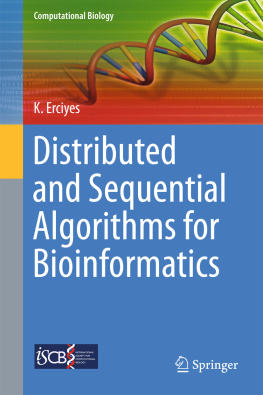Yunqing Rao - Intelligent Algorithms for Packing and Cutting Problem
Here you can read online Yunqing Rao - Intelligent Algorithms for Packing and Cutting Problem full text of the book (entire story) in english for free. Download pdf and epub, get meaning, cover and reviews about this ebook. year: 2022, publisher: Springer Nature Singapore, genre: Home and family. Description of the work, (preface) as well as reviews are available. Best literature library LitArk.com created for fans of good reading and offers a wide selection of genres:
Romance novel
Science fiction
Adventure
Detective
Science
History
Home and family
Prose
Art
Politics
Computer
Non-fiction
Religion
Business
Children
Humor
Choose a favorite category and find really read worthwhile books. Enjoy immersion in the world of imagination, feel the emotions of the characters or learn something new for yourself, make an fascinating discovery.
- Book:Intelligent Algorithms for Packing and Cutting Problem
- Author:
- Publisher:Springer Nature Singapore
- Genre:
- Year:2022
- Rating:3 / 5
- Favourites:Add to favourites
- Your mark:
- 60
- 1
- 2
- 3
- 4
- 5
Intelligent Algorithms for Packing and Cutting Problem: summary, description and annotation
We offer to read an annotation, description, summary or preface (depends on what the author of the book "Intelligent Algorithms for Packing and Cutting Problem" wrote himself). If you haven't found the necessary information about the book — write in the comments, we will try to find it.
Yunqing Rao: author's other books
Who wrote Intelligent Algorithms for Packing and Cutting Problem? Find out the surname, the name of the author of the book and a list of all author's works by series.
Intelligent Algorithms for Packing and Cutting Problem — read online for free the complete book (whole text) full work
Below is the text of the book, divided by pages. System saving the place of the last page read, allows you to conveniently read the book "Intelligent Algorithms for Packing and Cutting Problem" online for free, without having to search again every time where you left off. Put a bookmark, and you can go to the page where you finished reading at any time.
Font size:
Interval:
Bookmark:
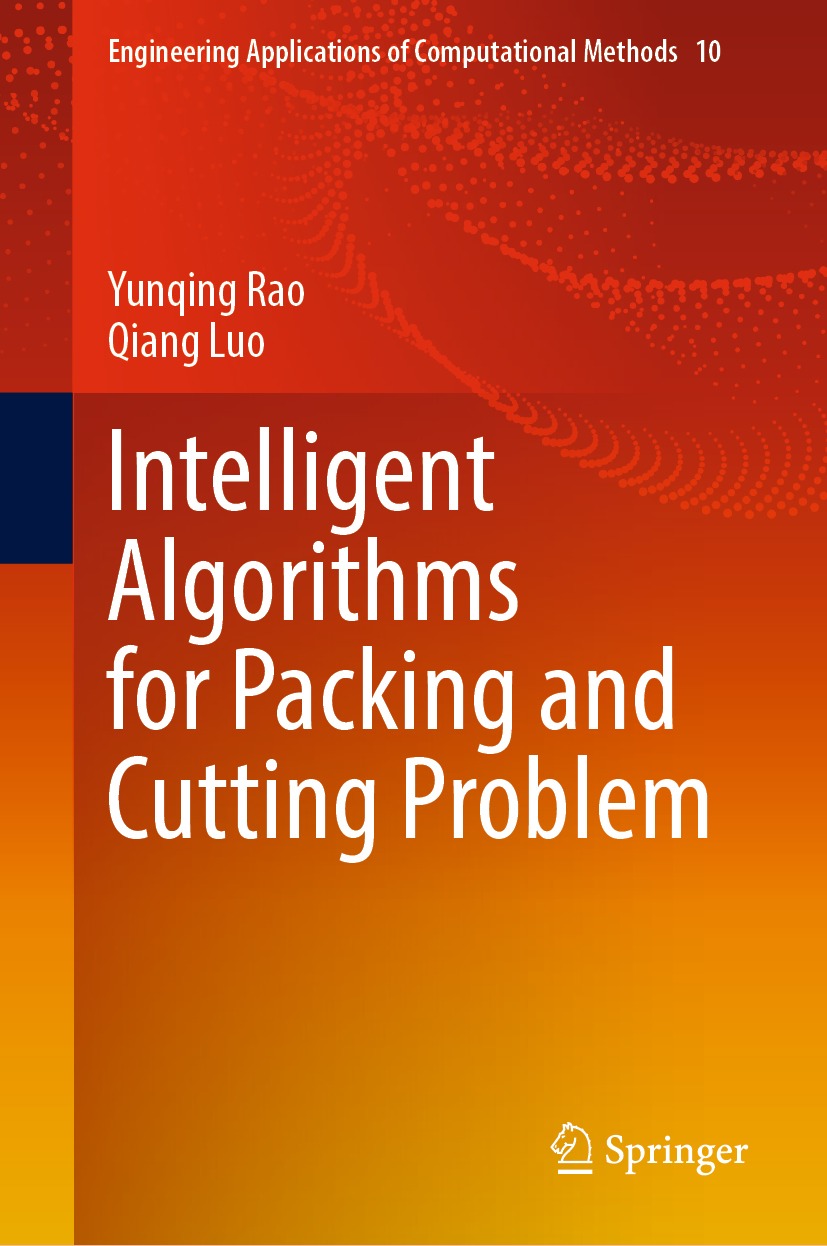
The book series Engineering Applications of Computational Methods addresses the numerous applications of mathematical theory and latest computational or numerical methods in various fields of engineering. It emphasizes the practical application of these methods, with possible aspects in programming. New and developing computational methods using big data, machine learning and AI are discussed in this book series, and could be applied to engineering fields, such as manufacturing, industrial engineering, control engineering, civil engineering, energy engineering and material engineering.
The book series Engineering Applications of Computational Methods aims to introduce important computational methods adopted in different engineering projects to researchers and engineers. The individual book volumes in the series are thematic. The goal of each volume is to give readers a comprehensive overview of how the computational methods in a certain engineering area can be used. As a collection, the series provides valuable resources to a wide audience in academia, the engineering research community, industry and anyone else who are looking to expand their knowledge of computational methods.
This book series is indexed in both the Scopus and Compendex databases.

The Springer logo.
This Springer imprint is published by the registered company Springer Nature Singapore Pte Ltd.
The registered company address is: 152 Beach Road, #21-01/04 Gateway East, Singapore 189721, Singapore
The two-dimensional packing and cutting problem widely exist in the production fields of machinery, electronics, ships, bridges, furniture, garments, leather, paper, glass, and other industries. The research and application development of optimized packing and cutting technology has been one of the hot issues of concern to both academia and industry since it can bring huge economic and social benefits. On the one hand, the application of this technology can reduce the labor intensity of employees, greatly improve the efficiency of packing, material utilization, and cutting efficiency, and help enterprises to reduce production costs, thus bringing them considerable economic benefits; on the other hand, it supports the concept of green manufacturing and helps the development of intelligent manufacturing technology. Through intelligent algorithms to optimize the packing, even a one percent increase in the material utilization rate will save lots of resource costs for enterprises and generate huge economic benefits for the whole society. Taking the machinery manufacturing industry as an example, the consumption of steel is great, especially in heavy industries such as heavy machinery, construction machinery, locomotives, ships, bridges, and other heavy industries where steel structure parts are mainly manufactured. By applying the intelligent optimization technology of packing and cutting in these industries, it is of great significance of not only reducing the manufacturing costs and improving economic efficiency but also saving resources and reducing energy consumption and emission reduction for the whole society.
The authors and their research team have started the research and application development of packing and cutting problem since the early 1990s, and the R&D results have been successfully applied in industrial production. In recent years, with the support of the National Natural Science Foundation of China and other funds, we have conducted more systematic and in-depth research on packing and cutting problem in combination with evolving intelligent optimization technology, have worked closely with relevant enterprises to carry out application research in the manufacturing industries of heavy machinery, construction machinery, special vehicles, port machinery, pressure vessels, steel structures, ships, bridges, printed circuit boards (PCB), transformers, etc., and have achieved large economic and social benefits. This book is a collection of our achievements in algorithm research, software development, and application in recent years. The main contents of this book include a variety of intelligent algorithms developed for rectangular and irregular packing and cutting problem, related software systems developed based on these algorithms, as well as their applications in industry.
The content of this book can be divided into four major parts, which describes in detail the mathematical modeling of 2D packing and cutting problem, intelligent solving algorithms, integrated software system design and development, and its engineering application cases. The first part is the introduction, which introduces the basic concepts of the two-dimensional packing and cutting problem, research status, and development trends. The second part is the study of algorithms for 2D packing problem, including the intelligent algorithms for rectangular packing problem, the intelligent algorithms for irregular packing problem, the new methods of 2D packing problem based on machine learning algorithms, and several special variants of packing problem and their solution methods. The third part is the study of the cutting problem, including the integrated technology and system development of 2D packing and plate cutting processing, and the intelligent algorithms for the plate cutting scheduling problem. The fourth part introduces several practical application cases of the methods presented in this book.
Font size:
Interval:
Bookmark:
Similar books «Intelligent Algorithms for Packing and Cutting Problem»
Look at similar books to Intelligent Algorithms for Packing and Cutting Problem. We have selected literature similar in name and meaning in the hope of providing readers with more options to find new, interesting, not yet read works.
Discussion, reviews of the book Intelligent Algorithms for Packing and Cutting Problem and just readers' own opinions. Leave your comments, write what you think about the work, its meaning or the main characters. Specify what exactly you liked and what you didn't like, and why you think so.

